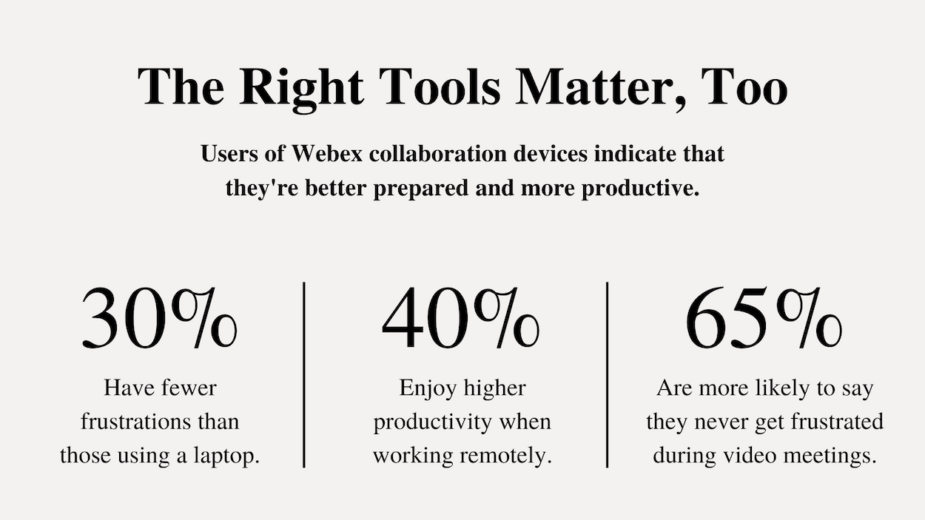We all know that hybrid work is the future of work. But it’s also both harder and different than ever before. The modern work environment is not confined to a single space or device anymore. It’s flexible, it’s mobile, it’s hybrid. Video Meeting Fatigue The Great Resignation
And then there’s video. We are all spending a lot of time in video meetings – even more than before the pandemic. This is our new normal. While there are many benefits to video meetings – easier collaboration, increased empathy from colleagues, and ultimately greater job satisfaction – there is a darker side as well.
A new study commissioned by Webex revealed the causes and consequences of video meeting fatigue. Yes, among all the aspects of employee well-being we are navigating, this has now been added to the list. In fact, 95% of workers experience video meeting fatigue! Since transitioning to remote work, not only are employees meeting through video conferencing tools, 56% said their time in meetings had increased since working from home.
But what’s behind this? Is video really the culprit? This study suggests otherwise.
First, let’s do the math. 93% of the workers surveyed spend more than 2 hours a day in video meetings – that’s 10 hours a week, more than 20% of their time. 66% of all video meetings are joined via laptop – and the data suggests that might not be a good thing.


What really caught my attention is that 42% of workers plan on leaving their current employer in the next two years – and there is a surprising link between video meeting habits and an employee’s decision to leave.The top issues negatively impacting video meetings are background noise, poor sound, and video quality, a trend that has continued for the last three years. These and other issues create video meeting fatigue and correlate with the 81% of knowledge workers and executives who experience physical ailments at the end of each day with video meetings. Over 30% experienced aches and pains, blurry vision, headaches, and eye strain, and nearly 40% experienced neck and shoulder strain.Herein lies our opportunity: to make the virtual workplace more inclusive, less stressful, more productive for organizations, and more satisfying for workers.
Over the last two years, employees have developed their own priorities regarding work. One of these priorities is work location. Of remote workers, 91% were emphatic that they wanted to stay at least partially remote – 54% hybrid and 37% exclusively remote, according to Gallup. Among GenZ workers, the numbers are even higher.
Hybrid work means finding ways to both accommodate employee priorities and reimagine the workplace to improve remote work. Business leaders like to say that people are their #1 asset. It’s true for us as well, so we are not only establishing policies to provide a flexible workplace, we want to improve the whole experience.
When asked what would reduce video meeting fatigue, two key areas were dominant: culture changes around meetings and better meeting technology. Survey participants were then divided into two groups: those that use Webex collaboration devices and those that use other devices (laptops, mobile devices, etc.), revealing two strong trends when compared. Those with Webex devices report higher levels of productivity, collaboration, improved culture, and having the right technology to do their work.

They reported 30% fewer frustrations than workers using a laptop, and Webex device users were nearly 40% more productive when working remotely. They had the right technology to reduce or even eliminate the debilitating effects of video meetings – background noise, poor sound quality, and poor video quality.
Our laptops are the most readily available technology for video meetings, but not the best choice. Devices better suited to video meetings not only reduce video meeting fatigue but provide a better experience for employees. Since 65% of video meetings are primarily done on laptops, and 45% of meetings are done on laptops without peripherals, it makes sense to give people better experiences with devices.
But what about culture changes? I noted above the positives of meeting on video. The corollary to the positives is this: people who rarely use video are 2.7x less likely to feel connected to company strategy and 3.2x more like to say they’re unhappy with their current employer.
So, we need video and yet video can lead to fatigue and burnout. Fundamentally, how companies use video technology matters.This is where something I call “simple kindness” comes into play. Leaders can implement policies to establish a kinder, gentler hybrid workplace. Workers have given us the answer. They asked for fewer back-to-back meetings, breaks between meetings, and company sanctioned no-meeting days.
Though such requests seem simple to implement, they require a strong commitment from management up and down the line. But the good news is that we do hold the power to alleviate video meeting fatigue.
There is another low-tech approach I think we might consider – the simple phone call. There are times when your part in a meeting is only to absorb information, or you need to quickly connect with a colleague to answer a question. The desktop phone, like the Cisco Video Phone 8875, can maximize productivity and reduce meeting fatigue.
I think you’ll find this study, The Data Behind Video Meeting Fatigue and How to Combat It, enlightening and helpful. Providing the right tech and the right culture is a winning combination that can help keep our most valuable assets healthy, safe, and happy.






